Solana Blockchain - Crypto Academy / S4W4 - Homework post for pelon53 by @salamdeen
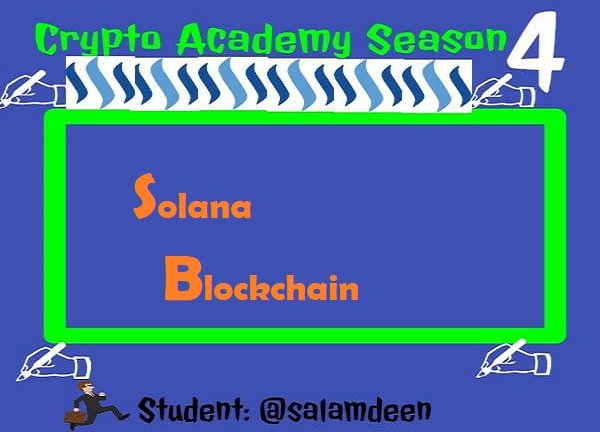
Created with MS paint
Before I start with the main tasks, I will like to write some introduction about Solana.
What is Solana?
Solana is a third generation open source blockchain network. Its white paper was published in 2017 by the founder (Anatoly Yakovenko ) and it was running on testnet until the mainnet was launched in March 2020. The affairs of the network are maintained by the Solana Foundation and Solana Labs
Solana uses a "Proof of stake" mechanism. It further improves the scalability and security of the other blockchain networks like Ethereum and Bitcoin by the implementation of 8 core innovations. Proof of History consensus protocol, Tower BFT (an improved version of PBFT), Turbine, Sea level, Golf Stream, Cloud Break, Archeivers, and Pipline these are the 8 core innovations . All these innovations have contributed to the network. Solana is currently the fastest blockchain network as it is able to complete over 50000 transactions per second with 200 distributed nodes. This is much higher than any known blockchain network so far.
Transactions on the Solana network are carried out in a fast and secure way. There is a lot of potential built on the Solana network. The last time I checked, there were about 368 projects listed categorically on Solana.net. Many of them are Defi, NFTs, DEXs, Dapps, and many other Web 3 projects.

The Proof Of History

P O H is the core innovation being used by the Solana blockchain network. It incorporates the network’s scalability, security, and decentralization. Solana uses the PoH alongside the Tower BFT (a modified version of PBFT). The Solana network is able to complete over 50000 transactions per second with 200 distributed nodes, thanks to the POH. PoH is able to improve the scalability in Solana by lightning the load of the network nodes for faster transactions. Just like Bitcoin and Ethereum, the timestamp is not recorded in the network because the other networks have no historical record of the previous events that occurred. PoH has solved this by encoding cryptographically generated time in the blockchain without depending on the clock of the local computer.
The encoded time can be utilized to clearly indicate the events that occurred in the network and the events that occurred before and after them. With PoH, validators solve some functions known as verifiable delay functions (VDFs). These functions are lighter, hence, they can be solved with just 1 core CPU using similar steps, which is much easier as compared to POW, where validators have to solve complex mathematical algorithms.
PoH uses these VFDs to hash the events and transactions that occur in the network with their respective time counts. This use of the VFDs has solved the challenge of time and, hence, increased the rate of processing. That is why the Solana network is more scalable as compared to the other networks. The hashes are generated through the PoH protocol. The PoH works in hand with the Tower BFT protocol. The validity of the hashes generated by the PoH protocol is then verified by witnesses in the network by voting. This process of voting is facilated by the Tower BFT protocol.

Some Use Cases Of Solana Blockchain

Mercurial Finance
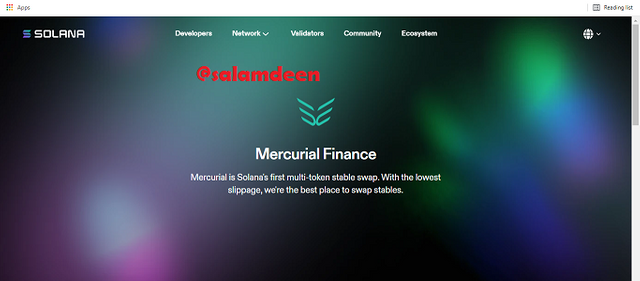
Source
Mercurial Finance is a Solana based defi insurance platform. It is the first successful project to be built on the Solana ecosystem. Mercurial is built on Solana as a result of the network’s high performance and strong potential. The network provides defi pools and vaults where users can store their stable coin. They have technical tools to allow users to deposit and mint their stable coins with ease.
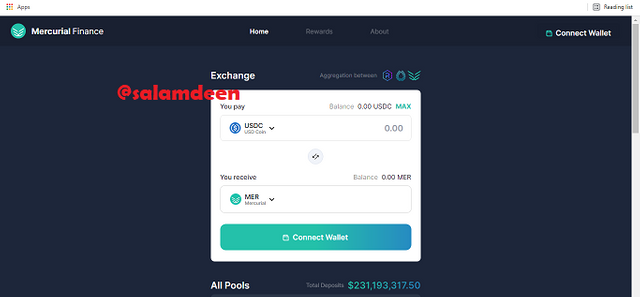
Interface of Mercurial Finance
When users put their assets on the platform, they are able to generate some liquidity. The assets in the platform are open to a variety of use cases, which include lending, flash loans, low-slippage swaps, and other decentralized protocols. The transactions in the network are facilitated by the strong performance of the Solana network. Mercurial is currently being backed by many organizations. Some of them are: Solana Ecosystem, OKEx, Coingecko, Nano, Blockfolio, and many others. The native token of the platform is MER and it is currently traded at approximately $0.4900 with a market cap of $490,878,379.13 and it is ranked 3223th in coinmarketcap
Serum
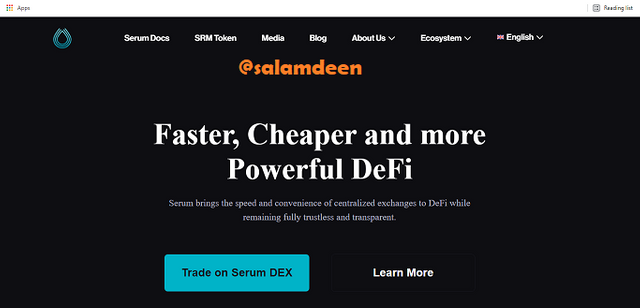
Source
Serum is a decentralized exchange built on the Solana ecosystem. It enables transactions with low cost and higher speed. The core ambition of the founders of Serum is to achieve 100% decentralization in a defi environment. The platform claims to be fully decentralized, hence, does not support KYC requirements.
One of the specialties of serum which makes it stand tall among other decentralized exchanges is that, it features an order book just like the centralized exchanges do. Currently, the platform has listed a variety of cryptocurrencies which are all being traded with the two popular stable coins, USDC and USDT.
Serum is permission-less and open source as it allows anyone to build their own DeXs and Defi games on the platform by following some instructions in the Serum academy. The platform has a cryptocurrency called Serum token. It is currently traded at approximately $7.10 with a fully diluted market cap of $72,160,075,831.00 and it is ranked 94th in [coinmarketcap.com]().

The Sola Token

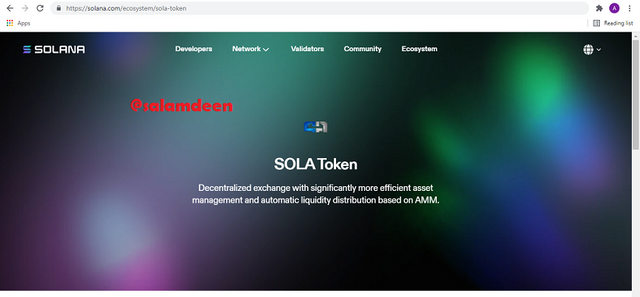
Source
The Sola token is a Defi built on the Solana network. It combines both decentralized exchange (DEX) and centralized exchange (CEX) functionalities. The Sola token offers a liquidity pool and it uses the AMM algorithm. It is the main algorithm currently being used by the majority of the liquidity pool decentralized exchanges. The Sola token has is partnered with Serum, a Solana-based DEX, and the order book feature used in Serum has been integrated into the Sola token exchange. Although, the platform is not fully operational for now, they have listed a number of crypto assets on the network which are all being traded with USDC and USDT and they can be traded on the platform.
The picture below shows the interface of the Sola token exchange.
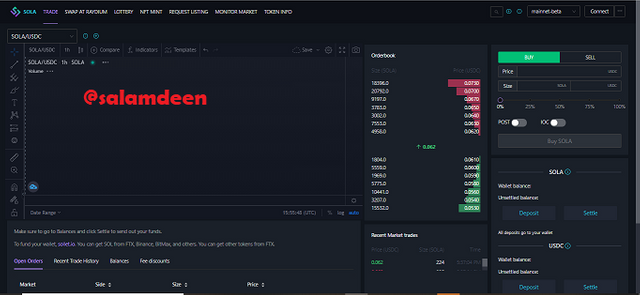
interface of Sola Token
When the Sola token becomes fully operational, users can stake, swap, and trade their tokens, mint NFTs, and even do the lottery on the platform. If you visit solatoken.net, they have outlined their roadmap which begins in the quarter 4 of this year. See in the picture below, some of the main functionalities and roadmap of the Sola Token.
Screenshots from solatoken.net
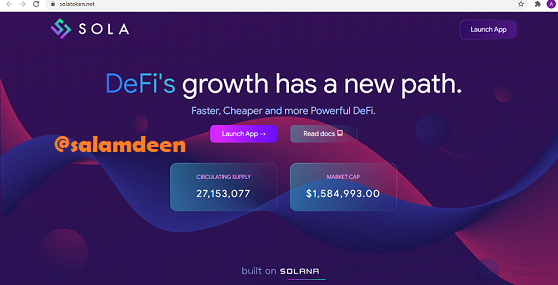.png)
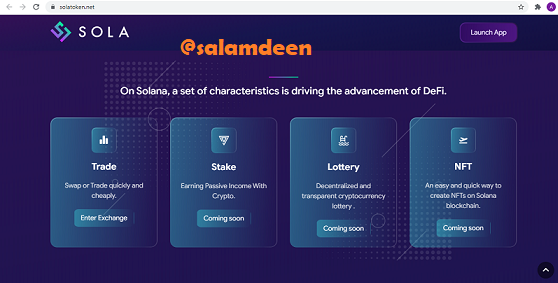.png)
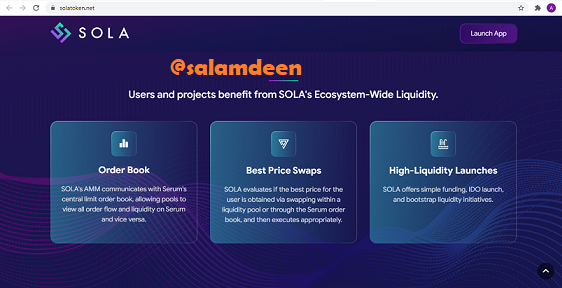.png)
The Road Map of Sola Token
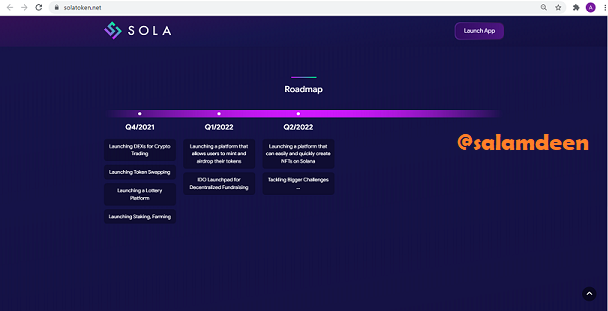.png)
The Sola Token Exchange have a native token called SOLA, This token is what they will use to grow the network. According to solatoken.net, the initial circulating supply of Sola is approximately 27 million, which is currently distributed by airdrops and other for traders and the platform's liquidity providers.
The SOLA Price Data From Coingecko
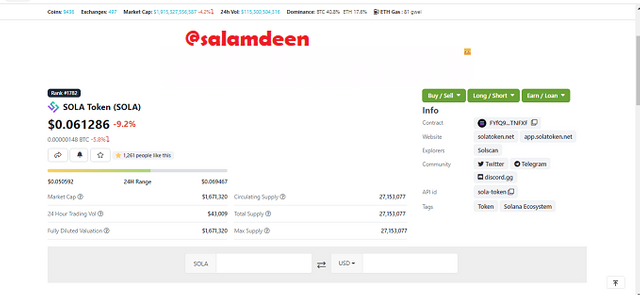
Sola Token in Coingecko

The September 14th Solana Incidence

The Solana network experienced a sudden interruption as the network’s block validations were interrupted on Tuesday, September 14th, 2021. This tragedy occurred at a period when the SOL token was gaining ground as the price rocketed from less than $2 in January this year to over $200 this month. This amazing performance of the token caught investors’ attention and the incident is believed to have been caused by data over load on the validator nodes as mass transactions were being carried out.
According to a statement released by Solana, it indicated that, the outage was as a result of resource exhaustion as the transactions on the network rose to 400000 TPS. The block processors started proposing forks, which led to some validation nodes going offline for almost 20 hours as they ran out of memory trying to process the mass forks. In another tweet by the founder of Solana, he indicated that, a denial of service had occurred as transactions were being generated by bots during the Grape Protocol’s IDO launch on a Solana based platform, Raydium. This incident, in addition to mass transactions in the network, has resulted in the interruption.
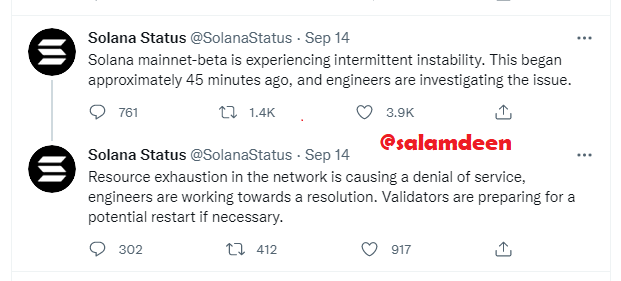
Solana Status twitter Post On 14th September 2021 Source
A hard fork was proposed by the Solana community, as a proof of stake network. They had to verify this proposal before implementing it. A consensus was reached to proceed with the hard fork after the proposal was endorsed by about 80% of the active stakeers in the network. The network was back to normal in about 2hrs time after the hard and the effect is not extreme on the network's main token as it was expected but some other projects running on the network are being negatively affected by this Incidence. The Solana native token SOL is currently trading at approximately $130, which is about 17% down from the price on the 14th of September.

The SOL token

The Sol Token is the Native Token being used on Solana.It is being used for the network’s tokenomics and as a Proof of stake platform, the validators are chosen from holders of the Sol token. It has seen some incredible gains this year, rising from less than $2 at the start of the year to more than $200 at the time of writing, and is currently trading at $130.
Price data of SOL in the coinmarket cap
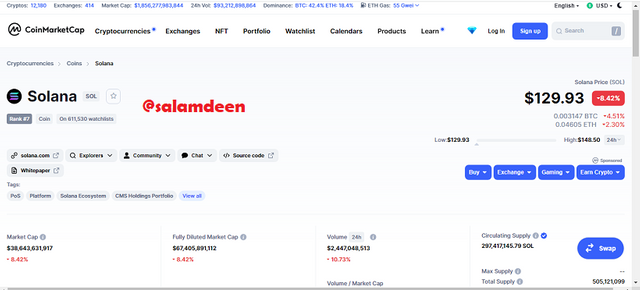
Source

Exploring Sola Explorer

Here, we are tasked by professor @pelon53 to explore the Solana Explorer.
First of all, I visited Solana Explorer, this is where we can track the activities of the Solana network.
The last block at this moment of performing this task is #98762333
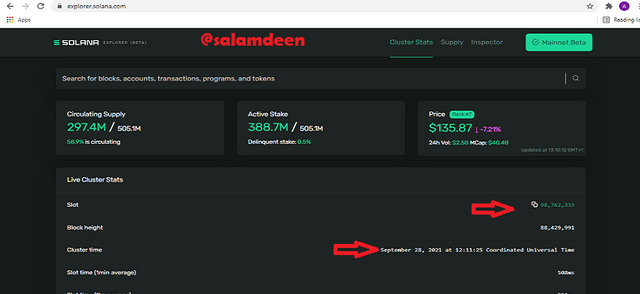.png)
Solana Exporer
I checked the details of block 1 to block 10 and couldn’t see any time.
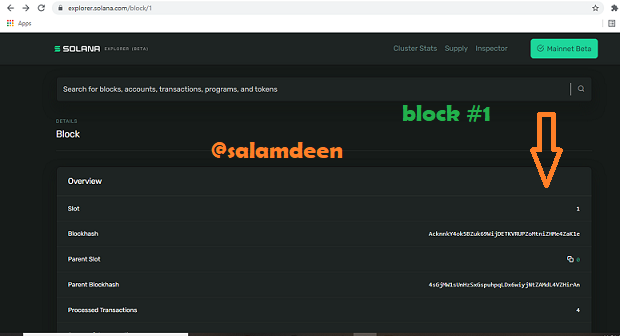.png)
The Solan Explorer
From the lecture, the professor indicated that the Solana mainnet was launched in March 2020, which is almost 18 months ago. Taking that into consideration, the mainet has been operating for 1.8 years.

Calculating the time interval of each block since the initial block

Time of operation = 18 months
Time of operation in Seconds = 18 x 2,630,000 = 47340000 Seconds
Average Time per Block =47340000 / 98762333 = 0.47933254067 ~~ 0.5 Seconds
From the above calculation, it has been proven that, each block is generated every approximately .5 seconds. This means that,approximately ,2 blocks are generated every second since the network operations started.

Conclussion

I want to conclude here by thanking the professor for this wonderful lecture. Solana is indeed a powerful blockchain and a lot of projects that are built on the Solana network are doing well in the blockchain. In exploring the Sola Token, I have realized it is a wonderful platform yet, unknown to many. I have really learnt a lot in the process of performing this task. Thank You
cc;
@pelon53
Gracias por participar en Steemit Crypto Academy Season 4, Semana 4:
Recomendaciones:
Era necesario profundizar un poco más sobre el cálculo de bloques por segundo.
Espero seguir leyendo tus publicaciones.
Calificación: 9.5